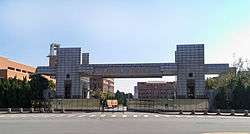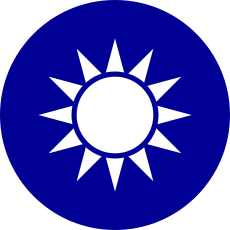Taoyuan, Taiwan
| Taoyuan 桃園市 | |||
|---|---|---|---|
| Special municipality | |||
| Taoyuan | |||
|
From left to right, top to bottom: China Airlines passenger plane on the Taoyuan International Airport, Taoyuan district , Yongan Fishing Port, HSR Taoyuan Station, Daxi Old Street of Baroque architecture, Shihmen Reservoir, Small Wulai Waterfall | |||
| |||
 | |||
| Coordinates: 24°59′28.6″N 121°18′51.58″E / 24.991278°N 121.3143278°ECoordinates: 24°59′28.6″N 121°18′51.58″E / 24.991278°N 121.3143278°E | |||
| Country | Taiwan | ||
| Region | Northern Taiwan | ||
| Seat | Taoyuan District | ||
| Districts | |||
| Government | |||
| • Type | Taoyuan City Government | ||
| • Mayor | Cheng Wen-tsan (DPP) | ||
| • Deputy Mayor | Chiu Tai-san[1] | ||
| Area[2][3] | |||
| • Special municipality | 1,220.95 km2 (471.41 sq mi) | ||
| • Urban | 1,140 km2 (440 sq mi) | ||
| Area rank | 14 of 22 | ||
| Population (2016)[4] | |||
| • Special municipality | 2,116,988 | ||
| • Rank | 5 of 22 | ||
| • Density | 1,700/km2 (4,500/sq mi) | ||
| • Urban[Note 1][5] | 8,500,000 | ||
| • Urban density | 7,500/km2 (19,000/sq mi) | ||
| Time zone | National Standard Time (UTC+8) | ||
| Postal code | 320-338 | ||
| ISO 3166 code | TW-TAO | ||
| Bird | Formosan blue magpie (Urocissa caerulea) | ||
| Flower | Peach blossom | ||
| Tree | Peach tree | ||
| Website | www.tycg.gov.tw (English) | ||
| |||
| Taoyuan, Taiwan | |||||||||||||||
| Traditional Chinese | 桃園市 | ||||||||||||||
|---|---|---|---|---|---|---|---|---|---|---|---|---|---|---|---|
| Simplified Chinese | 桃园市 | ||||||||||||||
| |||||||||||||||

Taoyuan (Chinese: 桃園市; pinyin: Táoyuán Shì), is a special municipality in northwestern Taiwan, neighboring New Taipei, Hsinchu County, and Yilan County. Taoyuan District is the seat of the municipal government and that which, along with Zhongli District, forms a large metropolitan area. Taoyuan developed from a satellite city of Taipei metropolitan area to be the fourth-largest metropolitan area, and fifth-largest populated city in Taiwan. Since commuting to the Taipei metropolitan area is easy, Taoyuan has seen the fastest population growth of all cities in Taiwan.
"Taoyuan" means "peach garden," since the area used to have many peach blossom trees. The city is home to many industrial parks and tech company headquarters. Taipei Taoyuan International Airport, which serves the capital, Taipei and the rest of northern Taiwan, is located in this city.
The city of Taoyuan has been elevated to special municipality status since 2014 from the original Taoyuan County. At the same time, the former county-controlled city of Taoyuan was also promoted to Taoyuan District within the new municipality.[6]
History
Early History
In ancient times, the Taoyuan plateau was the home of the Taiwanese plains aborigines. In prehistory, the Ketagalan people settled in Nankan. In the early years of Dutch colonization, Spanish colonization, and Zheng He of the Ming Dynasty, there were no large-scale cultivation or industrial activities. During the Qing era, a number of people from Fujian Province and Guangdong province began to immigrate into present-day Taoyuan to develop and farm the land. They planted peach trees, which, when fully bloomed in spring, were so beautiful that the people named the land Toahong (Chinese: 桃仔園; pinyin: Táozǐyuán; Pe̍h-ōe-jī: Thô-á-hn̂g; literally: "peach orchard").
Empire of Japan (1895–1945)

In November 1901, under Japanese rule, a local administrative office, Toshien Chō (Japanese: 桃仔園廳), was established in the area. In 1909, the number of cho were reduced and the local unit was renamed Tōen Chō (桃園廳). In 1920, the Tōen area was incorporated into Shinchiku Prefecture.
During the Japanese era, the staged migration policy caused Taoyuan to develop into a city with a variety of cultures. For example, temples and worship paths (currently the Taoyuan Martyrs Shrine) symbolized cultural systems. Butokuden (武德殿) were used to represent military systems, and the old Taoyuan City Office signified political systems.
Republic of China (1945–present)
In 1950, Taoyuan County was established by the Republic of China government. On 21 April 1971, Taoyuan City was made the capital of Taoyuan County. At the edge of the Greater Taipei region, this caused some structural and lifestyle changes within Taiwanese society. Trade prosperity in recent years and the proliferation of job opportunities helped Taoyuan develop into a major economic district in northern Taiwan and the population has increased ever since.
On December 25, 2014, Taoyuan County was reorganized from a county to become a special municipality named Taoyuan City (桃園市).
Geography
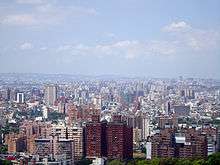
Taoyuan is located approximately 40 km (25 mi) southwest of Taipei, in northern Taiwan, and occupies 1,220 km2 (470 sq mi). It is made up of low-lying plains, interconnected mountains and plateaus. Its shape has a long and narrow southeast-to-northwest trend, with the southeast in the Xueshan Range and the far end on the shores of the Taiwan Strait.
There are many irrigation ponds at Taoyuan Plateau, which caused Taoyuan to earn the nickname "Thousand-pond Township" (千塘之鄉).[7]
Climate
Taoyuan has a humid subtropical climate, with mild to warm winters and hot summers, typical of northern Taiwan.
(The climate data of Taipei City is shown below for reference due to the city's proximity to Taipei.)
| Climate data for Taipei (1981–2010) | |||||||||||||
|---|---|---|---|---|---|---|---|---|---|---|---|---|---|
| Month | Jan | Feb | Mar | Apr | May | Jun | Jul | Aug | Sep | Oct | Nov | Dec | Year |
| Average high °C (°F) | 19.1 (66.4) |
19.6 (67.3) |
22.1 (71.8) |
25.7 (78.3) |
29.2 (84.6) |
32.0 (89.6) |
34.3 (93.7) |
33.8 (92.8) |
31.1 (88) |
27.5 (81.5) |
24.2 (75.6) |
20.7 (69.3) |
26.6 (79.9) |
| Daily mean °C (°F) | 16.1 (61) |
16.5 (61.7) |
18.5 (65.3) |
21.9 (71.4) |
25.2 (77.4) |
27.7 (81.9) |
29.6 (85.3) |
29.2 (84.6) |
27.4 (81.3) |
24.5 (76.1) |
21.5 (70.7) |
17.9 (64.2) |
23 (73.41) |
| Average low °C (°F) | 13.9 (57) |
14.2 (57.6) |
15.8 (60.4) |
19 (66) |
22.3 (72.1) |
24.6 (76.3) |
26.3 (79.3) |
26.1 (79) |
24.8 (76.6) |
22.3 (72.1) |
19.3 (66.7) |
15.6 (60.1) |
20.4 (68.7) |
| Average relative humidity (%) | 78.5 | 80.6 | 79.5 | 77.8 | 76.6 | 77.3 | 73 | 74.1 | 75.8 | 75.3 | 75.4 | 75.4 | 76.61 |
| Mean monthly sunshine hours | 80.6 | 71.3 | 89.6 | 92.6 | 113.7 | 121.7 | 179 | 188.9 | 153.7 | 124 | 99.4 | 90.7 | 1,405.2 |
| Source: Central Weather Bureau[8] | |||||||||||||
Ethnic composition
| Historical population | ||
|---|---|---|
| Year | Pop. | ±% |
| 1985 | 1,211,249 | — |
| 1990 | 1,355,175 | +11.9% |
| 1995 | 1,524,127 | +12.5% |
| 2000 | 1,732,617 | +13.7% |
| 2005 | 1,911,161 | +10.3% |
| 2010 | 2,002,060 | +4.8% |
| 2015 | 2,105,780 | +5.2% |
| Source:"Populations by city and country in Taiwan". Ministry of the Interior Population Census. | ||
Han Chinese
Hoklo
As of the rest of Taiwan, the Hoklo are one of the largest ethnic groups of Taoyuan, most of whom live in northern Taoyuan (北桃園), which comprises most northern districts of the city, including Bade, Daxi, Dayuan, Guishan and Luzhu, and the city seat of government, Taoyuan District.
Hakka
The Hakka are the second-largest ethnic group in the city after the Hoklo, most of them residing in southern Taoyuan (南桃園), which includes Zhongli, Pingzhen, Pingzhen, Longtan, Guanyin and Xinwu districts. With more than 785,000 Hakka people, Taoyuan hosts the largest Hakka population among all of Taiwan's administrative divisions.
Waishengren
After the Chinese Civil War, many people from mainland China (unaffectionately referred to as "Waishengren") settled in the then-Taoyuan County after the retreat of the nationalist government in 1949. Most of them live in military dependents' villages in Zhongli, Pingzhen and Guishan. Longgang is well known for its immigrants from Yunnan, featuring many Yunnan-style restaurants.
Aborigines
Most Taiwanese aborigines in the city live in Fuxing District, with most of them belonging to the Atayal people.
Economy
Taoyuan is one of the Taiwan's top industrial and technology city. High-tech companies including Quanta, MiTAC, Inotera, Nanya Technology, HTC, CPT and AU Optronics have all opted to build or expand their factories in Taoyuan. Taoyuan has now become a bastion of global electronics, optoelectronics display and semiconductor manufacturing. Over 200 of Taiwan's top 500 manufacturing companies have factories in Taoyuan. Taoyuan has also led Taiwan in terms of industrial output for nine straight years.
There are now 29 (registered) industrial areas with 3,696 ha (9,130 acres) of non-urban industrial land and 3,131 ha (7,740 acres) of urban industrial land. There are over 6,827 ha (16,870 acres) of land available for factories and industrial use in the city, representing the fact that Taoyuan's development bureau is based on industry and commerce. There are also 9 sites (57 ha; 140 acres) for mixed industrial-commercial use, the most of any county and city in Taiwan.[9]
On March 26, 2010, China Airlines moved into its new headquarters on the grounds of Taipei Taoyuan International Airport and in Dayuan Township in Taoyuan County (now Dayuan District, Taoyuan).[10][11] EVA Air maintains its headquarters in Luzhu District.[12] Evergreen Airlines Services Corporation, Evergreen Aviation Technologies Corp., and Evergreen Air Cargo Services Corporation, subsidiaries of Evergreen Group, are headquartered in Dayuan.[13][14][15]
Administration

Taoyuan City is divided into 12 districts and 1 mountain indigenous district.
| English | Mandarin | Land Area (in km2) | Population |
|---|---|---|---|
| Bade | 八德區 | 33.71 | 187,848 |
| Daxi | 大溪區 | 105.14 | 93,388 |
| Dayuan | 大園區 | 87.39 | 85,667 |
| Fuxing | 復興區 | 350.78 | 10,932 |
| Guanyin | 觀音區 | 87.98 | 64,845 |
| Guishan | 龜山區 | 72.01 | 145,706 |
| Longtan | 龍潭區 | 75.23 | 118,648 |
| Luzhu | 蘆竹區 | 75.50 | 155,626 |
| Pingzhen | 平鎮區 | 47.75 | 218,290 |
| Taoyuan | 桃園區 | 34.80 | 427,815 |
| Xinwu | 新屋區 | 85.02 | 48,469 |
| Yangmei | 楊梅區 | 89.12 | 161,301 |
| Zhongli | 中壢區 | 76.52 | 390,251 |
Prior to its upgrade to become municipality on 25 December 2014, Taoyuan County used to have 6 county-controlled cities (Bade, Luzhu, Pingzhen, Taoyuan, Yangmei, Zhongli), 1 urban township (Daxi), 5 rural townships (Dayuan, Guanyin, Guishan, Longtan, Xinwu), and 1 Mountain indigenous township (Fuxing).
Tourism
Shimen Reservoir
Shihmen Reservoir (traditionally spelled "Shihmen") (石門水庫) is one of Taiwan's major reservoirs. Once the largest water conservancy project in Southeast Asia, visitors may find many restaurants open near the reservoir serving fresh reservoir fish delicacies. There is also a three km-long (1.9 mi) bicycle track surrounding the back pond. Shimen Reservoir provides almost all of the water in Taoyuan, as well as to New Taipei City's Xinzhuang, Banqiao, and Linkou districts.
Daxi Old Street
Daxi Old Street is one of the more famous Taiwanese old streets. It used to be a bustling hub for camphor and the tea trade, filled with diverse stores with façades designed in a Baroque style.
Cihu Mausoleum
Cihu Mausoleum (慈湖陵寢) is the final resting place of the former president of the Republic of China, Chiang Kai-shek.
Window on China Theme Park
The Window on China Theme Park (小人國主題樂園) is one of Taiwan's earliest theme parks, established in 1984. The park consists of three areas: Mini World, Water Park, and Amusement Park. The park features numerous small-scale replicas of many famous world landmarks.
Lalashan
Lalashan (拉拉山) is one of Taiwan's "natural protection zones," including 500- to 2,800-year-old divine trees and the "No. 5 Divine Tree," which predates Confucius.
Taoyuan Martyrs' Shrine
Taoyuan Martyrs' Shrine (桃園忠烈祠) is one of the best-kept Shinto shrines outside Japan.
Longgang Mosque
The Longgang Mosque (龍岡清真寺) in Zhongli District is Taiwan's fifth mosque. It was originally built in 1967 to serve an area with many Taiwanese Muslims.
Government and Politics
Leaders
In 2001, Eric Chu of the Kuomintang defeated Democratic Progressive Party incumbent Peng Shao-Chin in the race for Taoyuan County magistrate. Peng had inherited the magistrate position after Annette Lu vacated the post to serve as vice president. Chu ran for re-election in 2005 and defeated DPP challenger Pao-Ching Cheng, CEO of the Taiwan Salt Company.
In 2009, John Wu of the KMT defeated his DPP opponent, Cheng Wen-tsan and became the Magistrate of Taoyuan County.
After the upgrade of Taoyuan County to Taoyuan City, Cheng Wen-tsan of the DPP won the 2014 Taoyuan City mayoralty election, on November 29, 2014, and became the city's first mayor, starting December 25, 2014.[16]
Presidential elections
1996 presidential election
A majority of Taoyuan County residents voted for eventual winner Lee Teng-hui and vice president Lien Chan.
2000 presidential election
| Party | Candidate | Votes | Percentage | ||
|---|---|---|---|---|---|
| President | Vice President | ||||
| Independent | James Soong | Chang Chau-Hsiung | 413,370 | 43.83% | |
| Kuomintang | Lien Chan | Vincent Siew | 208,881 | 22.15% | |
| New Party | Li Ao | Elmer Fung | 1,140 | 0.12% | |
| Independent | Hsu Hsin-Liang | Josephine Chu | 20,581 | 2.18% | |
| Democratic Progressive Party | Chen Shui-Bian | Annette Lu | 299,120 | 31.72% | |
2004 Presidential election
| Party | Candidate | Votes | Percentage | ||
|---|---|---|---|---|---|
| President | Vice President | ||||
| Democratic Progressive Party | Chen Shui-Bian | Annette Lu | 448,770 | 44.68% | |
| Kuomintang | Lien Chan | James Soong | 555,688 | 55.32% | |
2008 presidential election
| Party | Candidate | Votes | Percentage | ||
|---|---|---|---|---|---|
| President | Vice President | ||||
| Democratic Progressive Party | Frank Hsieh | Su Tseng-Chang | 379,416 | 35.36% | |
| Kuomintang | Ma Ying-Jeou | Vincent Siew | 693,602 | 64.64% | |
2012 presidential election
| Party | Candidate | Votes | Percentage | ||
|---|---|---|---|---|---|
| President | Vice President | ||||
| Democratic Progressive Party | Tsai Ing-Wen | Su Chia-chyuan | 445,308 | 39.85% | |
| Kuomintang | Ma Ying-Jeou | Wu Den-yih | 639,151 | 57.20% | |
| Independent (or seen as PFP) | James Soong | Lin Ruey-shiung | 32,927 | 2.95% | |
Education
Public universities
- Central Police University
- National Central University
- National Defense University
- National Taiwan Sport University
Private universities
- Chang Gung University
- Chien Hsin University of Science and Technology
- Chung Yuan Christian University
- Kainan University
- Lunghwa University of Science and Technology
- Vanung University
- Yuan Ze University
Military Academies
- Army Academy R.O.C.
- Republic of China Army Communication, Electronics and Information School
- Republic of China Army Chemical School
- Republic of China Army Logistics School
- Republic of China Military Police School
Public high schools
- National Chungli High School
- National Neili Senior High School
- National Taoyuan Senior High School
- National Wu-Ling Senior High School
- National Yangmei Senior High School
- National Yangming Senior High School
- Taoyuan City Dasi Senior High School
- Taoyuan City Dayuan International Senior High School
- Taoyuan City Nankan Senior High School
- Taoyuan City Pingjhen Senior High School
- Taoyuan City Shoushan Senior High School
- Taoyuan City Yungfong Senior High School
Junior high schools
Elementary schools
Industry and environment
A former RCA facility is located in the city. The RCA facility is the source of significant trichloroethylene contamination.
Sports
Taoyuan is home to the Lamigo Monkeys, CPBL, team, which plays its home games at the Taoyuan International Baseball Stadium.
The Taoyuan County Stadium, built in 1993, is a multi-use stadium which is used mostly for football matches and it also has an athletics track. The stadium has a capacity of 30,000 people.[17] It is within walking distance South West from Taoyuan Senior High School Station of the Taiwan Railway Administration.
The Taoyuan Arena, also built in 1993, is an indoor sporting arena located in Taoyuan City. It's capacity is 15,000.[18] It is used to host indoor sporting events, such as basketball and volleyball.
The then-Taoyuan County is also the birthplace of Taiwanese professional golfer Yani Tseng and taekwondo athlete Chu Mu-Yen.
Transportation

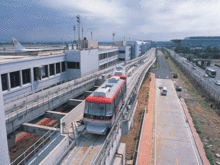
Rail
- Taoyuan Taolin Railroad (Linkou Line)
- The Taoyuan Taolin Railroad is a railway branch line in Taiwan run by the Taiwan Railway Administration. It is located in Taoyuan and New Taipei City.
- Taoyuan Station is located at the Qingpu (青埔) area, in Zhongli District.
Mass Rapid Transit
A rapid transit system is under construction. (See Taoyuan Mass Rapid Transit System.)
- Lines and stations of the Taoyuan MRT System:
| Line | Termini | Length (km) | Total Length (km) | Status | |||
|---|---|---|---|---|---|---|---|
| Taoyuan Airport MRT | Taipei | Sanchong | 4.1 | 53.5 | Under construction | ||
| Sanchong | Huanbei | 47.4 | Under construction | ||||
| Huanbei | Zhongli | 2.04 | Under construction | ||||
| Blue | Airport Terminal 2 | Huanbei | 17 | 25.4 | Under construction | ||
| Huanbei | Zhongli | 2.04 | Under construction | ||||
| Zhongli | Bade | 6.36 | Planning | ||||
| Red | Fengming | Zhongli | 15.95 | 29.3 | Under construction | ||
| Zhongli | Fugang | 13.35 | Planning | ||||
| Green | Bade | Dayuan | 27.2 | 27.2 | Planning | ||
| Orange | Main Line | Shanzaiding | Huiji Jr High | 22.7 | Planning | ||
| Longtan Line | Shanzaiding | Longtan | Planning | ||||
| Brown | Taolin Line | Taoyuan | Shanbi | 12.5 | 24.5 | Planning | |
| Huilong Line | Taoyuan | Huilong | 12 | Planning | |||
| Taipei Metro: Blue-Sanying Line |
Dingpu | Fongming Jr High | 13.2 | 18.6 | Planning | ||
| Fongming Jr High | Mayuan | 5.4 | Planning | ||||
Road
National Highway No. 1 and 3 are nearby and connect via local highways to the city itself. National Highway No. 2 connects to Taoyuan International Airport.
Bus
- Taoyuan Bus Co. (Chinese)
- Zhongli Bus Co. (Chinese)
On 19 July 2016, a suicidal bus driver killed 24 tourists, two tour guides, and himself.
Air
Taipei Taoyuan International Airport at Dayuan District is the largest airport in Taiwan. It serves as the main international hub for China Airlines and EVA Air. Taipei Taoyuan handled a total of 25,114,418 passengers in 2010. It is the fifteenth-busiest air freight hub in the world and thirteenth-busiest airport by international passenger traffic. Taipei Taoyuan International Airport currently has two terminals which are connected by two, short people movers. A third terminal is planned, and a rapid transit system currently under construction will link the terminals together underground.
International relations
Twin towns — Sister cities
 Hartford County, Connecticut, United States (1982)
Hartford County, Connecticut, United States (1982) Alameda, California United States (1977)
Alameda, California United States (1977) Miaoli City, Taiwan (2006)
Miaoli City, Taiwan (2006) Dallas County, Texas United States (2007)
Dallas County, Texas United States (2007) Inchon, South Korea (2009)
Inchon, South Korea (2009)
Relative location
 |
Taiwan Strait |  | ||
| Taiwan Strait Fujian, |
|
| ||
| ||||
| | ||||
| |
See also
References
- ↑ http://www.chinapost.com.tw/taiwan/national/national-news/2015/01/22/427128/Cheng-promises.htm
- ↑ "《中華民國統計資訊網》縣市重要統計指標查詢系統網" (in Chinese). Retrieved 13 June 2016.
- ↑ "Demographia World Urban Areas PDF (April 2016)" (PDF). Demographia. Retrieved 13 June 2016.
- ↑ "人口統計-桃園市政府民政局". cab.tycg.gov.tw (in Chinese). 7 March 2014. Retrieved 6 June 2016.
- ↑ "Demographia World Urban Areas PDF (April 2016)" (PDF). Demographia. Retrieved 2016-06-06.
- ↑ "桃園縣103年改制直轄市 名為「桃園市」". The Epoch Times. 24 April 2012. Retrieved 29 April 2012.
- ↑ "農田水利入口網". coa.gov.tw.
- ↑ "Climate". Central Weather Bureau.
- ↑ "Overview of the Overall Industrial and Commercial Development".MIT Taoyuan.
- ↑ "move.htm." China Airlines. Retrieved on 15 March 2010.
- ↑ "China Airlines Inaugurates CAL Park at Taoyuan Airport." China Airlines. 26 March 2010. Retrieved on 26 March 2010.
- ↑ "Evergreen Club." EVA Air. 24/28. Retrieved on 21 May 2009.
- ↑ "Contact Us." Evergreen Aviation Technologies Corp. Retrieved on 29 September 2009.
- ↑ "Contact Us." Evergreen Airlines Services Corporation. Retrieved on 29 September 2009.
- ↑ "Company Location." Evergreen Air Cargo Services Corporation. Retrieved on 29 September 2009.
- ↑ http://vote2014.nat.gov.tw/en/TC/n300000000000000.html
- ↑ www.fussballtempel.net
- ↑ 桃園市政府體育局
External links
| Wikimedia Commons has media related to Taoyuan City. |
- Taoyuan City Government official website (Chinese)
- Taoyuan City Government official website (English)
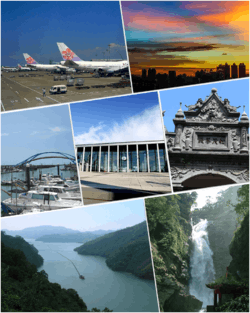

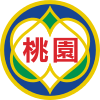


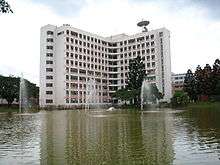
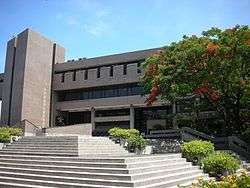

_NDU_side_gate_on_Shingfeng_Road.jpg)
